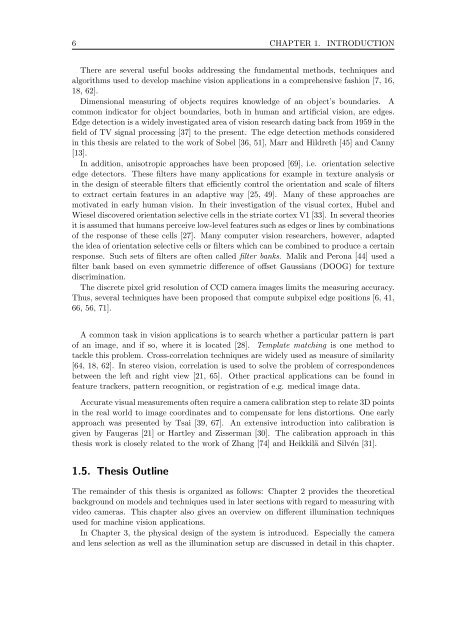Master Thesis - Fachbereich Informatik
Master Thesis - Fachbereich Informatik
Master Thesis - Fachbereich Informatik
Create successful ePaper yourself
Turn your PDF publications into a flip-book with our unique Google optimized e-Paper software.
6 CHAPTER 1. INTRODUCTION<br />
There are several useful books addressing the fundamental methods, techniques and<br />
algorithms used to develop machine vision applications in a comprehensive fashion [7, 16,<br />
18, 62].<br />
Dimensional measuring of objects requires knowledge of an object’s boundaries. A<br />
common indicator for object boundaries, both in human and artificial vision, are edges.<br />
Edge detection is a widely investigated area of vision research dating back from 1959 in the<br />
field of TV signal processing [37] to the present. The edge detection methods considered<br />
in this thesis are related to the work of Sobel [36, 51], Marr and Hildreth [45] and Canny<br />
[13].<br />
In addition, anisotropic approaches have been proposed [69], i.e. orientation selective<br />
edge detectors. These filters have many applications for example in texture analysis or<br />
in the design of steerable filters that efficiently control the orientation and scale of filters<br />
to extract certain features in an adaptive way [25, 49]. Many of these approaches are<br />
motivated in early human vision. In their investigation of the visual cortex, Hubel and<br />
Wiesel discovered orientation selective cells in the striate cortex V1 [33]. In several theories<br />
it is assumed that humans perceive low-level features such as edges or lines by combinations<br />
of the response of these cells [27]. Many computer vision researchers, however, adapted<br />
the idea of orientation selective cells or filters which can be combined to produce a certain<br />
response. Such sets of filters are often called filter banks. Malik and Perona [44] used a<br />
filter bank based on even symmetric difference of offset Gaussians (DOOG) for texture<br />
discrimination.<br />
The discrete pixel grid resolution of CCD camera images limits the measuring accuracy.<br />
Thus, several techniques have been proposed that compute subpixel edge positions [6, 41,<br />
66, 56, 71].<br />
A common task in vision applications is to search whether a particular pattern is part<br />
of an image, and if so, where it is located [28]. Template matching is one method to<br />
tackle this problem. Cross-correlation techniques are widely used as measure of similarity<br />
[64, 18, 62]. In stereo vision, correlation is used to solve the problem of correspondences<br />
between the left and right view [21, 65]. Other practical applications can be found in<br />
feature trackers, pattern recognition, or registration of e.g. medical image data.<br />
Accurate visual measurements often require a camera calibration step to relate 3D points<br />
in the real world to image coordinates and to compensate for lens distortions. One early<br />
approach was presented by Tsai [39, 67]. An extensive introduction into calibration is<br />
given by Faugeras [21] or Hartley and Zisserman [30]. The calibration approach in this<br />
thesis work is closely related to the work of Zhang [74] and Heikkilä and Silvén [31].<br />
1.5. <strong>Thesis</strong> Outline<br />
The remainder of this thesis is organized as follows: Chapter 2 provides the theoretical<br />
background on models and techniques used in later sections with regard to measuring with<br />
video cameras. This chapter also gives an overview on different illumination techniques<br />
used for machine vision applications.<br />
In Chapter 3, the physical design of the system is introduced. Especially the camera<br />
and lens selection as well as the illumination setup are discussed in detail in this chapter.














